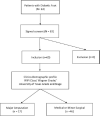Comparison of WIFi, University of Texas and Wagner Classification Systems as Major Amputation Predictors for Admitted Diabetic Foot Patients: A Prospective Cohort Study
- PMID: 33403071
- PMCID: PMC7751999
- DOI: 10.5704/MOJ.2011.018
Comparison of WIFi, University of Texas and Wagner Classification Systems as Major Amputation Predictors for Admitted Diabetic Foot Patients: A Prospective Cohort Study
Abstract
Introduction: Classifications systems are powerful tools that could reduce the length of hospital stay and economic burden. The Would, Ischemia, and Foot Infection (WIFi) classification system was created as a comprehensive system for predicting major amputation but is yet to be compared with other systems. Thus, the objective of this study is to compare the predictive abilities for major lower limb amputation of WIFi, Wagner and the University of Texas Classification Systems among diabetic foot patients admitted in a tertiary hospital through a prospective cohort design.
Materials and methods: Sixty-three diabetic foot patients admitted from June 15, 2019 to February 15, 2020. Methods included one-on-one interview for clinico-demographic data, physical examination to determine the classification. Patients were followed-up and outcomes were determined. Pearson Chi-square or Fisher's Exact determined association between clinico-demographic data, the classifications, and outcomes. The receiver operating characteristic (ROC) curve determined predictive abilities of classification systems and paired analysis compared the curves. Area Under the Receiver Operating Characteristic Curve (AUC) values used to compare the prediction accuracy. Analysis was set at 95% CI.
Results: Results showed hypertension, duration of diabetes, and ambulation status were significantly associated with major amputation. WIFi showed the highest AUC of 0.899 (p = 0.000). However, paired analysis showed AUC differences between WIFi, Wagner, and University of Texas classifications by grade were not significantly different from each other.
Conclusion: The WIFi, Wagner, and University of Texas classification systems are good predictors of major amputation with WIFi as the most predictive.
Keywords: University of Texas classification; WIFi; diabetic foot; major amputation; wagner.
© 2020 Malaysian Orthopaedic Association (MOA). All Rights Reserved.
Figures
Similar articles
-
Association Between the Society for Vascular Surgery (SVS)-WIfI (Wound, Ischemia, Foot Infection) Classification, Wagner-Meggitt Classification, and Amputation Rate in Patients With Diabetic Foot Infection.Int J Low Extrem Wounds. 2024 Mar;23(1):33-42. doi: 10.1177/15347346231208342. Epub 2023 Oct 19. Int J Low Extrem Wounds. 2024. PMID: 37853714
-
Repeatability, Completion Time, and Predictive Ability of Four Diabetes-Related Foot Ulcer Classification Systems.J Diabetes Sci Technol. 2023 Jan;17(1):35-41. doi: 10.1177/1932296820986548. Epub 2021 Jan 15. J Diabetes Sci Technol. 2023. PMID: 33451251 Free PMC article.
-
A Comparison Between Diabetic Foot Classifications WIfI, Saint Elian, and Texas: Description of Wounds and Clinical Outcomes.Int J Low Extrem Wounds. 2022 Jun;21(2):120-130. doi: 10.1177/1534734620930171. Epub 2020 Jun 28. Int J Low Extrem Wounds. 2022. PMID: 32594809
-
Are current wound classifications valid for predicting prognosis in people treated for limb-threatening diabetic foot ulcers?Int Wound J. 2024 Jan;21(1):e14338. doi: 10.1111/iwj.14338. Epub 2023 Aug 9. Int Wound J. 2024. PMID: 37555265 Free PMC article.
-
WIfI classification: the Society for Vascular Surgery lower extremity threatened limb classification system, a literature review.J Vasc Bras. 2020 May 8;19:e20190070. doi: 10.1590/1677-5449.190070. J Vasc Bras. 2020. PMID: 34178056 Free PMC article. Review.
Cited by
-
Prediction models for amputation after diabetic foot: systematic review and critical appraisal.Diabetol Metab Syndr. 2024 Jun 10;16(1):126. doi: 10.1186/s13098-024-01360-6. Diabetol Metab Syndr. 2024. PMID: 38858732 Free PMC article. Review.
-
Outcomes of integrated surgical wound treatment mode based on tibial transverse transport for diabetic foot wound.Front Surg. 2023 Jan 16;9:1051366. doi: 10.3389/fsurg.2022.1051366. eCollection 2022. Front Surg. 2023. PMID: 36726959 Free PMC article.
-
Predictive model and risk analysis for outcomes in diabetic foot ulcer using eXtreme Gradient Boosting algorithm and SHapley Additive exPlanation.World J Diabetes. 2025 Jul 15;16(7):104789. doi: 10.4239/wjd.v16.i7.104789. World J Diabetes. 2025. PMID: 40697589 Free PMC article.
-
Machine Learning Insights Into Amputation Risk: Evaluating Wound Classification Systems in Diabetic Foot Ulcers.Int Wound J. 2025 Jun;22(6):e70515. doi: 10.1111/iwj.70515. Int Wound J. 2025. PMID: 40462388 Free PMC article.
-
Descriptive Analysis of Anatomical Location and Metabolic and Microbiological Factors in Diabetic Foot (DF) Treated at a DF Specialty Tertiary Care Hospital With a Multidisciplinary Approach.Cureus. 2025 Mar 16;17(3):e80690. doi: 10.7759/cureus.80690. eCollection 2025 Mar. Cureus. 2025. PMID: 40242699 Free PMC article.
References
-
- Alcantara AS, Araza L, Mercado-Asis L, Tan-Alora A. Bacterial Infections among Filipino Diabetics at the Santo Tomas University Hospital. Phil J Microbiol Infect Dis. 1999;28(3):91–7.
-
- Reiber GE, Boyko EJ, Smith DG. Diabetes in America. 2nd ed. United States: National Institute of Diabetes and Digestive and Kidney Diseases, National Institutes of Health; 1995. Lower extremity foot ulcers and amputations in diabetes; pp. 409–28. In: National Diabetes Data Group (NNDG).
-
- Frykberg RG, Armstrong DG, Giurini J, Edwards A, Kravette M, Kravitz S et al. Diabetic foot disorders: a clinical practice guideline. American College of Foot and Ankle Surgeons. J Foot Ankle Surg. 2000;39(5 suppl):S1–60. - PubMed
-
- Mills JL Sr, Conte MS, Armstrong DG, Pomposelli FB, Schanzer A, Sidawy AN et al. The Society for Vascular Surgery Lower Extremity Threatened Limb Classification System: Risk stratification based on Wound, Ischemia, and foot Infection (WIfI) J Vasc Surg. 2014;9(1):220–34. doi: 10.1016/j.jvs.2013.08.003. - DOI - PubMed
LinkOut - more resources
Full Text Sources



